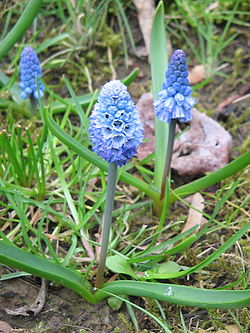| Pseudomuscari | |
|---|---|
 | |
| P. azureum | |
| Scientific classification | |
| Kingdom: | Plantae |
| Clade: | Tracheophytes |
| Clade: | Angiosperms |
| Clade: | Monocots |
| Order: | Asparagales |
| Family: | Asparagaceae |
| Subfamily: | Scilloideae |
| Genus: | Pseudomuscari Garbari & Greuter |
| Synonyms [1] | |
M. subg. Pseudomuscari(Losinsk.) D.C.Stuart | |
Pseudomuscari is a genus of bulbous perennials in the family Asparagaceae, subfamily Scilloideae. [2] They were formerly included in the genus Muscari (as the Pseudomuscari group, section or subgenus). Species of Pseudomuscari have flowers in shades of pale or bright blue, and are small plants with dense flower spikes or racemes. A feature which distinguishes them from Muscari is the bell-shaped flower which is not constricted at the mouth. One species, P. azureum , is popularly grown in gardens as an ornamental Spring-flowering plant. [3]



